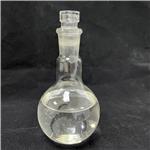Description
Trimethyl orthoformate is an effective solvent for thallium(III) nitrate-mediated oxidations. It undergoes acid catalyzed reaction with 6-(N-D-ribitylanilino) uracils to form 8-demethyl-8-hydroxy-5-deazariboflavins.
Chemical Properties
Colorless liquid. Slightly soluble in water, miscible with alcohol and oils.
Very diffusive, ethereal, pungent or nauseating odor, pleasant in dilution, slightly wineyfruity, Brandy-like.
Sweet taste in concentrations below 100 ppm.
Barely perceptible at 10 ppm.
Uses
Trimethyl Orthoformate is the most simple orthoester. Used in organic synthesis as a reagent for introducing a protecting group for aldehydes and in the creation of methoxymethylene groups and heterocyclic ring systems.
Uses
Trimethyl orthoformate is used as a protecting group for aldehydes in organic synthesis, as an additive in polyurethane coatings and as a dehydrating agent in the preparation of surface modified colloidal silica nanoparticles. It is also used as a chemical intermediate in the preparation of vitamin B1 and sulfa drugs. It acts as an effective solvent for thallium(III) nitrate-mediated oxidations. Furthermore. It is utilized for the synthesis of chromone from keto-hydroxy naphthol in the presence of trimethylamine.
Uses
Trimethyl orthoformate can be used:
- To convert sulfonic acids to methyl esters.
- To convert 2-acylcyclohexanones to the corresponding acetal derivatives.
- To mediate Pinacol reaction of various 1,2-diols with tin(IV) chloride without the formation of water.
- To synthesize 1-substituted-1H-1,2,3,4-tetrazoles via a three-component condensation with amine and sodium azide catalyzed by indium triflate under solvent-free conditions.
- For the N-methylation of amines in the presence of sulfuric acid.
Application
Trimethyl orthoformate was used as dehydrating agent in the preparation of surface-modified colloidal silica nanoparticles.
MOM protection of Diols using Trimethyl Orthoformate
N-Formylation of Amino Acid Esters
General Description
Trimethyl orthoformate is an effective solvent for thallium(III) nitrate-mediated oxidations. It undergoes acid catalyzed reaction with 6-(
N-D-ribitylanilino) uracils to form 8-demethyl-8-hydroxy-5-deazariboflavins.
Flammability and Explosibility
Highly flammable
Safety Profile
A skin and eye irritant.
A very dangerous fire hazard when exposed
to heat or flame; can react with oxidizing
materials. Hazardous to prepare. To fight
fire, use CO2, fog, haze. When heated to
decomposition it emits acrid smoke and
irritating fumes. See also ESTERS.
Synthesis
Trimethyl orthoformate is prepared on an industrial scale by the methanolysis of hydrogen cyanide:
HCN + 3 HOCH3 → HC(OCH3)3 + NH3
Trimethyl orthoformate can also be prepared from the reaction between chloroform and sodium methoxide, an example of the Williamson ether synthesis.
Toxics Screening Level
The initial threshold screening level (ITSL) for trimethyl orthoformate is 800 μg/m3 based on an annual averaging time.
Precautions
Moisture sensitive. Keep the container tightly closed in a dry and well-ventilated place. Incompatible with acids and strong oxidizing agents.
References
Protection for the Hydroxyl Group, Including 1,2- and 1,3-Diols
P. G. M. Wuts, in Greene's Protective Groups in Organic Synthesis, 5th ed., ed. by P. G. M. Wuts, John Wiley & Sons, Inc., Hoboken, New Jersey, 2014, Chap. 2, 17.
A Facile Procedure for the Synthesis of N-Formyl Amino Acid Esters
T. Chancellor, C. Morton, Synthesis 1994, 10, 1023.







